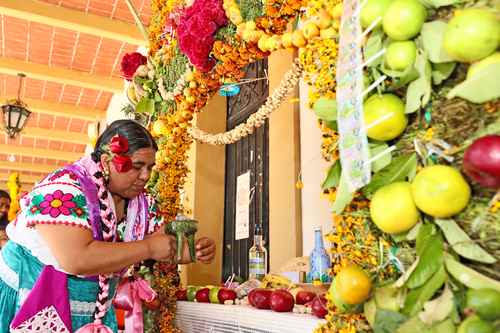▲ Each region of Oaxaca has its own products, but there is no lack of arches with flowers and fruits through which, according to tradition, the spirits pass, in addition to the culinary delights of this state rich in customs.Photo Roberto Garcia Ortiz
Laura Poy Solano
sent
Newspaper La Jornada
Monday, October 31, 2022, p. 12
Tlacolula De Matamoros, Oax., Between cempasúchil flowers and incense, fruit, tamales, mole, mezcal and candles, 13 altars for the dead recall the Zapotec, Mixe, Chinantec and Mazatec traditions that “open doors between the world of the living and of the dead to tell them: ‘welcome, we haven’t forgotten you,’” says Antelmo García Robles, a community educator accompanying the National Council for Educational Development (Conafe) who works in the Cañada region.
Gathered in the first exhibition of altars and offerings for the dead, convened by that organization in this municipality with the aim of disseminating the culture and traditions of the hundreds of towns where they teach, young educators from different regions of the state highlight that all this was possible thanks to the support of the communities that donated much of what was put into the offerings, because there is a pride and affection for the tradition
.
The task is to preserve the traditions
García Robles is one of the 3,800 Conafe teachers dedicated to serving 38,000 children and adolescents who reside in small rural towns with high and very high marginalization, which is why he underlines the importance of keep our traditions together. We made this effort hand in hand with our students, who sought information about the tradition of the Day of the Dead in their towns, with their grandparents, parents and uncles. It is a very nice way to teach them to preserve the tradition
.
In San Gabriel Mixtepec, which means hill between clouds
, in the heart of the Chatino region, the customs to commemorate the deceased bring families and the community together; In this hot area, where coffee is grown and people live by fishing for shrimp and mojarras, cocoa is a symbol of the fruits that the Earth offers and is not lacking in their altars for the dead.
In the same way as in San Lucas Ojitlán, fishing and its products are present to remember those who have left. With flowers and copal, the altars are decorated with bananas, tangerines, reeds, oranges and coconuts.
Atole, tamales, mole and mezcal are among the favorite foods of Oaxacans, living and dead, as is the case in the town of Arroyo Choápam, municipality of San José Chilatepec, which adorns its altars with colorful cempasúchil flowers and in which pineapples and watermelons cannot be missing.
In our communities we organize many days before the Day of the Dead, from October 27 and 28 the preparations begin
narrates Nancy, one of the community educators who participated in the installation of the altar in the Loma Bonita region, in Tuxtepec, right in the center of the Chinantec zone. Everyone participates in the tasks to receive our loved ones, from preparing the food to setting up the altar. When everything is ready, we take out chairs in front of the door of the house so that our faithful departed know that we are waiting for them with pleasure.
.
García Robles points out that in the communities of San Martín Toxpalan, in the Cañada region, an arch of flowers is placed in each offering that represents the portal between the world of the living and the dead. It is decorated with 180 flowers divided into 13 bouquets. We have the belief that when its shadow is reflected, there is another arch with 180 flowers in the world of the dead and that together they make 360 days of the year.
.
You also have to add new things
Unlike other indigenous communities in Oaxaca, On our altars for the deceased, we not only put the food and drinks that they enjoyed the most, but also new things, the dishes that you have been getting to know or a new fruit that you ate, because you have the idea that it is shared with them not only lived, but the new experiences you have when they are no longer
.
The bread, which symbolizes the bodies of the souls that visit their loved ones; salt, which purifies them; the water, which quenches their thirst; the incense, which raises the prayers for his eternal rest, and the candles, which give light to his arrival and return to the world of the dead, accompany each offering that from the Coast region to the Mountain of Oaxaca maintain the tradition for the deceased, in one of the entities with the most cultural diversity in Mexico.
From the Isthmus of Tehuantepec, with one of the most colorful altars, the tradition of the Zoques, Mixes, Zapotecs and Ikoots is combined, in offerings in which, in addition to food, incense and bread, they are accompanied by music to wait for loved ones who are already they departed When they await their arrival, they do so with a little mezcal and usually sing their other Zapotec hymn: Genda Nabani (life).
















